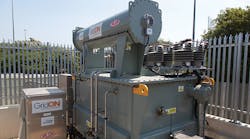One of the major challenges facing the electric industry is how to manage network fault levels, the magnitude of the electrical current that flows into a fault or short circuit. These current levels are critical. It is not possible to detect a fault if the current is too small, so no action can be taken to isolate the fault. If the current is too large, there is a risk of equipment damage, power interruptions or safety implications.
Fault current, like normal load current, flows from a source of electricity, such as a generator, through the network to the point of fault, and is limited by network impedance. Typically, the fault level is high in areas of high demand where the network is strong, such as large urban areas in close proximity to generation.
The increase in embedded generation, with the dual objectives of economic growth and moving toward a low-carbon economy, can contribute to the network fault level. Where there are constraints on network fault levels, this can restrict, postpone or increase the cost of sustainable development. This is the position in the U.K., and in 2010, the Energy Technologies Institute (ETI) commissioned a project to accelerate the development and commercialization of reliable solutions.
Fault Current Limiter
The ETI project aimed to develop a new technology solution to the high fault level problem and demonstrate it on a distribution network. Several technologies can prevent damaging fault currents, but the project aimed to develop a novel approach to one of these technologies — GridON’s fault current limiter (FCL) — to offer significant advantages over the existing solutions.
UK Power Networks, Uniper Technologies (formerly E.ON Technologies) and GridON partnered with ETI to trial a superconductor-free, inductive-type device in a transformer feeder position. This location on the network presents a few demands on a FCL:
• It needs to carry full load current. And because it will carry high currents regularly, it requires a lower nominal impedance and voltage drop than some other applications.
• It needs to reduce but not interrupt the fault current, as some current must be supplied to ensure downstream protection operates correctly.
• It needs to be able to support normal load current immediately after the fault has cleared with minimum distortion.
The FCL concept uses the electromagnetic properties of an iron core that, when put into deep magnetic saturation, presents a low nominal insertion impedance. Then, when a higher fault current is present, the core is driven out of saturation, presenting higher impedance, thus limiting the fault current. This design is fail-safe, because no external trigger or power supply is required for the current limiting. The FCL was manufactured by GridON’s partner Wilson Transformer Co.
Physically, there is little to distinguish the GridON FCL from a normal power transformer. The FCL uses standard transformer materials (for example, copper coils, iron core and oil) and can be manufactured using standard transformer production lines. This provides the network operator with the assurance — unlike some other FCL technologies — that the device can be serviced and supported over its lifetime, which is expected to span more than 40 years. The similarity to transformers provides additional benefits to the network operator, such as well-understood transformer installation, maintenance and protection.
The design scales well in both current and voltage, following existing transformer technology. It differs from transformers by having an additional control cubicle housing the direct-current auxiliary power supplies used to saturate the core magnetically. This presents an additional maintenance requirement to clean and replace air filters on a regular basis, the frequency of which depends on the local environment (a task that falls within existing inspection schedules).
Operational Experience
The FCL was installed and energized in UK Power Networks’ 33/11-kV substation in Newhaven, East Sussex, England, in May 2013. The substation is equipped with three 10-MVA 33/11-kV transformers, one of which runs on hot standby to avoid exceeding the fault-level rating of the existing 11-kV switchgear. The FCL was installed on the 11-kV side of transformer T3, with a rating equivalent to the transformer (10-MVA nominal, 15-MVA overload). The FCL enables the substation to run with all three 33/11-kV transformers connected to the 11-kV bus bars with a fault level of 11.3 kA. This enables the switchgear in the substation to remain in operational service without exceeding its 13.12-kA fault rating.
Before it was installed, the FCL went through rigorous testing, including factory tests according to transformer and reactor standards as well as short-circuit tests in a certified high-power laboratory. ETI, Uniper and UK Power Networks staff witnessed the tests, and the FCL was approved for installation. The test results also were used to update a behavioral model of the FCL introduced into network simulation software, representing Newhaven’s entire 11-kV network. This model, built by the project’s technical consultant, Uniper Technologies, was designed for load-flow, short-circuit and time-domain analyses of the network with the FCL in circuit.
There was added complexity at the Newhaven town site, as the transformer circuit breakers provide a backup to the outgoing feeders in the unlikely event one of the circuit breakers fails to open correctly. This is achieved by careful grading of the protection settings on the circuit breakers, based on the available range of fault currents. The impact of the FCL on this protection scheme was assessed and examined by UK Power Networks and validated by Uniper Technologies, ensuring the FCL could be connected without creating any problems.
Since its installation, the FCL has experienced more than 16 passages of fault current. The substation and the FCL have been fitted with monitoring equipment to record normal-state voltages and currents as well as waveforms during fault events. The data captured during fault events has been assessed, comparing the measured fault current reduction with the expected levels. The details and location of the fault were reproduced on the model of the network, enabling verification of the FCL performance, modeling and impact on the network.
Two typical passages of fault current were the result of a fault and the subsequent localization of the fault, restoring supplies to as many customers as possible by network switching. The fault was identified as a cable fault that started as a phase-to-phase-to-earth fault and then evolved to a three-phase-to-earth fault, for a duration of 760 msec in the first instance and 740 msec in the second instance. With only the 33/11-kV transformers T2 and T3 (with FCL) in service, the recorded root-mean-square (rms) fault currents were 3.3 kA and 1.2 kA, respectively.
This confirmed a 64% reduction in the fault current “pushed” from the high-impedance path with the FCL in circuit to the lower-impedance path through T2. The simulated rms fault current through each transformer without the FCL in circuit is 2.5 kA, so the FCL provides a 52% reduction. However, as the FCL can only impact half the fault current (that is, on one of two in-feeds), the reduction in overall fault level is approximately 15%.
In all of these studies, the measured values correlate closely with the design requirements, simulations and data from the laboratory testing. This provides further reassurance in the robustness of this solution as well as its performance predictability. The experience gained from these events confirms, when considering the installation of a FCL, the overall behavior of the network needs to be examined closely when specifying its performance parameters. It also is important to analyze the network behavior with the FCL in circuit, so as not to over-specify the FCL.
One benefit of the FCL demonstrated in service is its ability to recover instantly from fault current limitation to normal current carrying, unlike many FCLs using superconducting wires. This means, following fault clearance, the transformer feeder protected by the FCL resumes normal load-current operation immediately, thus increasing network availability.
Operation and Maintenance
The FCL is straightforward to maintain for distribution network operator staff because its maintenance schedule is almost identical to a distribution transformer’s schedule. During the first two years of operation, there were several planned inspections of the FCL and more frequent oil analysis than would be conducted normally. The inspections all pointed to the device behaving as one would expect of a transformer. Nothing unusual was identified during these assessments and there were no malfunctions during its operation.
The FCL requires a secure auxiliary supply, and its control includes an auto-start feature, ensuring it is ready for operation within a matter of seconds. Loss of this supply causes the FCL to lose magnetic saturation, which, although it does not affect fault current limitation, will distort the current through the FCL and could lead to unplanned outages. Secondary contacts were provided from the FCL to UK Power Networks’ protection system to provide visibility of availability of the FCL and warning of any potential problems. UK Power Networks’ control center took over its operation following commissioning as with any other device on the network.
The similarity of the FCL to a power transformer has been outlined clearly. However, one noticeable difference is that the magnetic saturation of the iron core in the FCL produces a direct-current magnetic field. The field strength is well within safe levels for both public exposure and operational staff, but considerations have been made for people who have cardiac implants. The effect of the magnetic field is noticeable when in close proximity to the FCL tank, although it has had no noticeable effect on the tank and cubicle-mounted equipment.
A Useful Tool
Fault-level-reduction techniques — for example, using high-impedance transformers, using reactors or splitting the network to reduce the number of in-feeds — have been available for many years. All solutions have their advantages and disadvantages, and it often is possible to replace high-voltage switchgear with units designed with a higher short-circuit capability.
For each application, the different options should be assessed and the most cost-effective solution chosen based on life-cycle costs. The FCL is a useful tool to help protect the network from excessive fault levels where low-maintenance long-life assets are desirable such as network operator applications.
The presaturated core FCL has proven itself as a reliable solution during laboratory testing and its time in operation on UK Power Networks system at the Newhaven substation. Its operation during normal conditions and in short-circuit events has been analyzed carefully and has been found to be in accordance with specifications and test results. It has reduced fault levels on site to the required level and also has improved the resilience of the network while having minimal impact on the network operation in normal conditions. GridON’s FCL also has proven to be simple for field operations and control center staff to operate.
Acknowledgement
The author wishes to acknowledge the support given by Uri Garbi of GridON, Nick Eraut of the Energy Technologies Institute, Nagaraju Pogaku of Uniper Technologies and Mohinder Pannu of Wilson Transformer Co.
Ian Cooper is a senior engineer on the innovation team at UK Power Networks, the distribution network operator for southeast England. His work involves technical leadership and project management of research, development and demonstration projects focusing on fault current mitigation, electrical energy storage and overhead line development. Cooper holds a master’s degree in electromechanical engineering from Southampton University.


